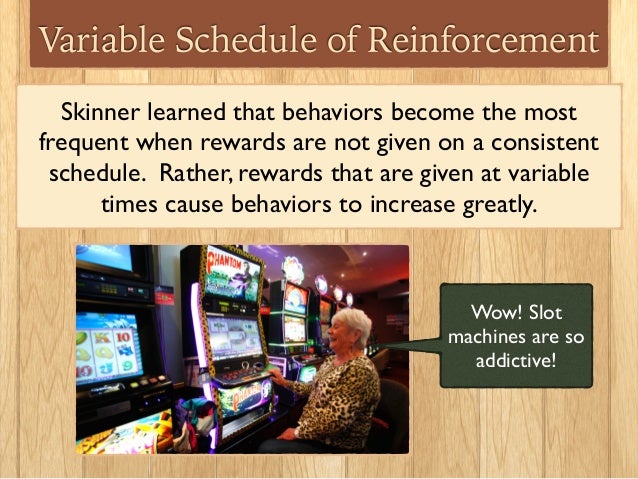According To Operant Conditioning What Is A Slot Machine An Example Of
The stimulus in whose presence a response will be reinforced is called the stimulus in operant conditioning Discriminative Piecework in a factory is an example of a schedule of reinforcement, a slot machine is an example of a schedule reinforcement. In a variable ratio schedule, the consequence (winning), follows after an AVERAGE number of responses (playing the game). So, for example, in a simplified slot machine with a 1:10,000 win to lose ratio for its jackpot, a player should hypothetically win on average every 10,000 plays.
Operant conditioning is a learning process whereby deliberate behaviors are reinforced through consequences. It differs from classical conditioning, also called respondent or Pavlovian conditioning, in which involuntary behaviors are triggered by external stimuli.
With classical conditioning, a dog that has learned the sound of a bell precedes the arrival of food may begin to salivate at the sound of a bell, even if no food arrives. By contrast, a dog might learn that, by sitting and staying, it will earn a treat. If the dog then gets better at sitting and staying in order to receive the treat, then this is an example of operant conditioning.
Operant Conditioning and Timing
The core concept of operant conditioning is simple: when a certain deliberate behavior is reinforced, that behavior will become more common. Psychology divides reinforcement into four main categories:
- Positive reinforcement
- Negative reinforcement
- Punishment
- Extinction
Timing and frequency are very important in reinforcement.
- A continuous reinforcement schedule (commonly abbreviated CRF) provides reinforcement for all noted behaviors. That is, every time the behavior occurs, reinforcement is provided.
- An intermittent reinforcement schedule (commonly abbreviated INT) reinforces some target behaviors but never all of them. Think of it like a slot machine. You won't win on every pull of the lever, but you do win sometimes, and that reinforces the behavior of pulling the lever.
Examples of Positive Reinforcement
Positive reinforcement describes the best known examples of operant conditioning: receiving a reward for acting in a certain way.
- Many people train their pets with positive reinforcement. Praising a pet or providing a treat when they obey instructions -- like being told to sit or heel -- both helps the pet understand what is desired and encourages it to obey future commands.
- When a child receives praise for performing a chore without complaint, like cleaning their room, they are more likely to continue to perform that chore in the future.
- When a worker is rewarded with a performance bonus for exceptional sales figures, she is inclined to continue performing at a high level in hopes of receiving another bonus in the future.
Examples of Negative Reinforcement
Negative reinforcement is a different but equally straightforward form of operant conditioning. Negative reinforcement rewards a behavior by removing an unpleasant stimulus, rather than adding a pleasant one.


- An employer offering an employee a day off is an example of negative reinforcement. Rather than giving a tangible reward, they reduce the presence of something undesirable; that is, the amount of time spent at work.
- In a sense, young children condition their parents through negative reinforcement. Screaming, tantrums and other 'acting out' behaviors are generally intended to draw a parent's attention. When the parent behaves as the child wants, the unpleasant condition - the screaming and crying - stops. That's negative reinforcement.
- Negative reinforcement is common in the justice system. Prisons will sometimes ease regulations on a well-behaved prisoner, and sentences are sometimes shortened for good behavior. The latter in particular is classic negative reinforcement: the removal of something undesirable (days in prison) in response to a given behavior.
Examples of Punishment
In psychology, punishment doesn't necessarily mean what it means in casual usage. Psychology defines punishment as something done after a given deliberate action that lowers the chance of that action taking place in the future. Whereas reinforcement is meant to encourage a certain behavior, punishment is meant to discourage a certain behavior.
- An employee who misses work may suffer a cut in wages. The loss of income (an undesired consequence) constitutes the punishment for missing work (an undesired behavior).
- A sharp 'No!' addressed to a pet engaging in unacceptable behavior is a classic example of punishment. The shout punishes the pet, conditioning it to avoid doing wrong behavior in the future.
- Punishments are commonly used in lab experiments. Most often, a lab animal is punished for a given behavior with a mild electric shock.
Just as there are examples of positive reinforcement and negative reinforcement, there are also examples of positive punishment (like the ones above) and negative punishment. With the latter, a positive situation is removed when an undesired behavior is performed. For example, a parent may take a favorite toy away from a child who is misbehaving.
Examples of Extinction
Psychology defines extinction as the loss of conditioning over time when the conditioning stimuli are no longer present. Over time, an animal (or person) will become less conditioned unless the stimuli that conditioned them in the first place is reapplied.
- An employee punished once for missing work, then never again, may become more likely to miss work later on because they no longer expect to be punished for absence.
- Animals often test the limits of their conditioning. For instance, a cat punished with a spray bottle every time it climbs on a counter may come near the counter, or jump on the counter when it believes no one is around. If no punishment occurs, the cat is likely to keep jumping on the counter because the conditioning against it is extinct.
- In school, if a student receives a gold star for an excellent test score, but does not receive more gold stars in subsequent tests, he may become increasingly unmotivated to perform well in future tests. The operant conditioning of the positive behavior (doing well on a test) is becoming extinct.
B.F. Skinner and Conditioning
Burrhus Frederic Skinner was a psychologist and researcher credited with establishing the principles of operant conditioning. B.F. Skinner began with Thorndike's law of effect, which states that behaviors that cause satisfactory results will be repeated. Skinner considered satisfaction to be insufficiently specific to measure, and set out to design a means of measuring learned behaviors.
According To Operant Conditioning What Is A Slot Machine An Example Offering
The operant conditioning chamber, popularly known as a Skinner box, was his solution. He kept his test subjects, primarily pigeons and rats, in circumstances that allowed him to closely observe their behavior. He would isolate the animal and every time the animal performed a defined behavior, like pushing a lever, it'd be rewarded with food. When the animal began to reliably push the lever, he'd know it had been conditioned.
Skinner's work took that first principle and applied it to human behavior, representing the school of psychology called behaviorism. Behaviorism defined much of psychology for the second half of the 20th century, but is currently being combined with other psychological perspectives.
Operant Conditioning and You
It can be uncomfortable to talk about human behavior in the clinical language of psychology. That said, operant conditioning describes a simple phenomenon that happens in every part of life. It's just one of the mechanisms by which people learn. It's vital to understand how that mechanism works to make sure it works best for you.
For more on the science behind conditioning, check out our article on Examples of Behaviorism. It's the school of psychology that focuses on observable behavior, rather than emotions or motives, to explain how and why people do the things they do.